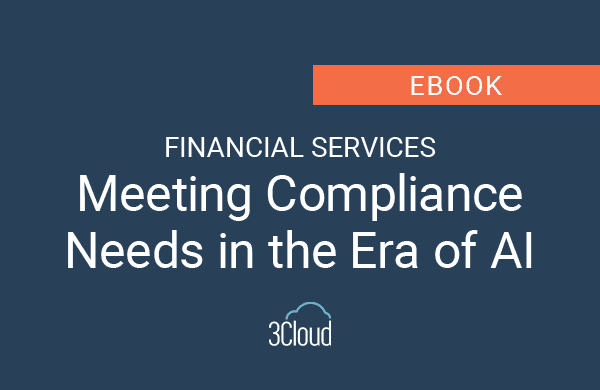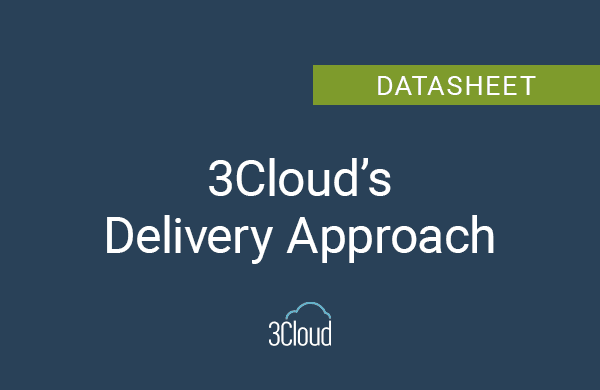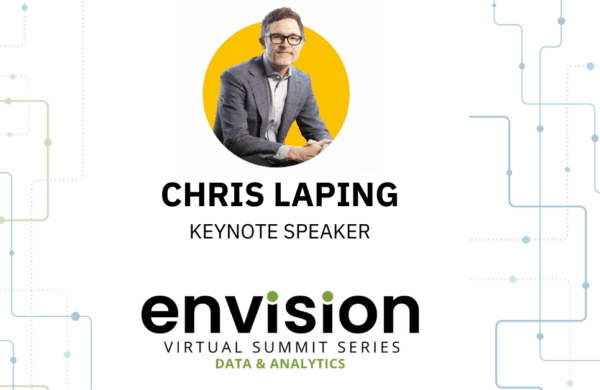The following is part 1 of the transcript from the webinar: “Top 8 Priorities When Shifting a Culture to be Data-Driven and Powered by All Employees, Not Just Some” with culture thought leader and Director of Delivery Excellence at 3Cloud, Steve Brown. Portions of this transcript have been revised with added context and reduced for brevity.
Frame your experience with shifting culture by reading our Learning Brief: Simple Mindshift for Managing Culture Change.
Steve Brown [06:28] When we think about data-driven cultures and specifically data-driven cultures, you know, this is a topic that I call the fringe or peripheral factors that make specific organizations extraordinary.
To be honest, a day in the life of Steve Brown is typically filled with databases, cloud computing, data warehouses, visualizations, Power BI, you know, the things that show you how likely you were to hit your target in 2020 should another global crisis happened.
So, it’s not often that I get to talk about, you know, the culture or fun side of my job. So, it’s exciting to be here. But, yes, those things are important to any organization. But it’s not enough to separate your organization from the rest.
What separates your company from the rest are great people who are enabled to do unthinkable things.
The journey we’ll take together is all about how to connect employees to your greatest asset. And that’s your data. Doing, this will create a culture in which ideas run wild and the innovation and opportunities are endless.
Small and powerful enhancements that I’m going to talk to you today about today that could just change your organization, intelligent enterprise, and how culture fits into that are something that we’ll talk through just a bit.
How Does Culture Impact Our Daily Lives?
[11:36] [Sharing image of post-race injury] I do realize that starting off this conversation with the huge photo of my disgusting left foot is just a bit risky, but I promise. It’ll make a lot of sense in a few minutes. So let me explain why I’m on this trail being chased by a random lady that I don’t even know. I’ll be at mile 30 or so. I know it was mile 34 before because I still had that big smile on my face.
It was about 8 pm on May 4, 2019, in the small town of Marietta, South Carolina, that incredible connection between me My poor left foot, my poor soul, my poor mind, and what it meant to leave it all on the line hit me like a ton of bricks. The gun went off, and the race began. It was within the first hour of the grueling and yet beautiful, somehow beautiful journey that I realized I had finally jumped off into the deep end.
Now, I’m not sure if it was the fact that the sunset before I hit biomarker to or the mosquitoes and horseflies that follow me closely waiting to feast on my corpse or the annoying super fast athletes zooming by me talking about their latest races. But the reality was, I was completely out of my league.
[12:56] At, I don’t know probably mile 26 or so the let’s just call the first marathon, I felt like I had a chance. By the second marathon. I just couldn’t wrap my head around only being halfway done. By my mile 75 or the third marathon. I have fractured my leg in two places.
And by mile 90 at 590. All I could think about is how my raw hands and knees are going to be when I had to crawl the last 10 miles because giving up was not an option. In a little over 37 hours, I finished the race. Overall, I’m extremely proud of completing my first and only attempt at 100 miles.
[13:38] Now the race wasn’t even where the magic happens. Then it happened during the 48 hours in which I was able to answer the 14 hours after which I was able to answer two very simple questions. simple questions yet critical questions. One was, what the hell are you thinking?
And two? How did you do it? Now? The first question is an easy one. What was I thinking? Well, to be honest, I really wasn’t it just sounded fun and then turn into a three-month recovery effort. The second question the how eventually landed on one word, one word that we’ll talk about a lot today and that word is culture.
I got there by following the five whys of incremental and interrogate of techniques to explore the cause-and-effect relationship of a particular problem, which for me was knocking down 100 miles in the woods during a torrential three-day thunderstorm.
[14:32] Why did you run the race? I asked myself, why did you think it was going to be fun? Why did your friends convince you? How are you mentally able? The answer, was my social behaviors, norms, as well as a little bit of knowledge, beliefs, customs capabilities, and habits of the group I grew up with, you know, my family. being the son of two Marines. This is perhaps not totally shocking our cultural norms.
Arms are to stop at nothing. In business, this works in a very similar way, the outcomes your organizations achieve, have a direct correlation to its culture.
When you are part of a winning culture, anything is possible.
[15:57] Let’s be honest, we live in a world where data is king. If you don’t know that, you will quickly begin to figure that out. Figuring out how to shift your culture to enable every employee to make decisions based on data analytics in the future. As I said, this is not hard, it can be fun, and the payoff could be huge.
What Companies Excel in Culture?
And in fact, if you don’t believe me, just ask Haier, a company that consistently outperforms some of the biggest household names in America such as Whirlpool, LG Electrolux. In fact, over the past decade, they have seen gross profits and revenue grow by more than 20% year over year while creating more than 2 billion and the market value of new ventures alone.
How may you ask? Small enhancements, not wholesale changes, or complete culture overhauls
[16:53] For Haier, one of the small fun incremental changes that they made was to treat each employee as an entrepreneur. And that is part of what we’re going to talk about today.
It’s easy to think that the basic definition of culture, is simple, organic, you know, adoption of behaviors, but it’s not.
In the world that we live in, it’s more likely a well-thought-out well-planned component of a robust and complex business strategy, or at least it should be. organizational culture is a system of shared values, beliefs, and assumptions that govern how people behave within an organization.
Now, make no mistake about it. We are all gainfully employed because our organizations have not totally figured it out. They don’t have all the answers, right. But if you need a few examples of companies who are running strong at mile 90 with broken limbs, then here are a few.
These [successful] companies all have one thing in common. They have created a culture in which employees have the green light and the ability to challenge the status quo. Their leaders, their peers, the direct reports have the word enablement in their DNA, unlike me and my race, and initially struggling to answer how the employees of these organizations live the how every day. This includes everything from random yet creative watercooler conversations, to having a fully robust data set at their fingertips in which they can do things like I don’t know, analyze the risk profile of the company’s next big bet. These employees eat, sleep, and breathe the house.
Culture at the Center of Driving Intelligent Enterprises
[18:34] Now I want to take a moment to talk about how culture fits into a broader ecosystem of the intelligent enterprise. At 3Cloud, we believe that your success as it relates to data and analytics depends on all six of these areas. Culture is just one of them. If there’s only one thing, you’re able to take away from today’s presentation, hopefully, there’s more than one it should be that culture alone will not get you there.
If your organization is looking for the complete picture, please give me a call. And we can have a much deeper conversation about the other spokes that will give you the competitive advantage.
There’s a reason why culture is number two is second on this list. It is critical as you move from your traditional company models to the models of the future, the Ubers and the Tesla’s of the world
What is ROCI – Return on Cultural Investments?
Let’s talk about ROI and what I like to call the ROCI. For many of us the light bulbs don’t go off until we are able to connect the topics like these $2 and cents, right let’s be honest, most of us are part of organizations that want to make money and do good.
[20:00] It’s common sense, or conversely, negatively affects their satisfaction and performance. It really takes no time to research this. The data and science behind [ROCI] are extremely hard to challenge.
- Organizations that are intentional about how they develop their culture experience a 14% turnover rate compared to 48-50% for organizations that ignore this experience
- Ignoring Cultural impact can cost 2.5x a person’s annual salary.
- Ignoring your company’s culture may also lead to a 33% decrease in operating income
Key takeaways:
- Culture is at the heart of every successful company.
- Companies like Haier focus on Entrepreneurship to work smarter in bringing new ideas to customers and empowering staff.
- Investments in culture can reduce employee churn while avoiding cultural investments can lead to negatively impact performance.
- Companies concerned with the value of culture should calculate Return on Cultural Investment and consider value-added benefits to employees and business success.




